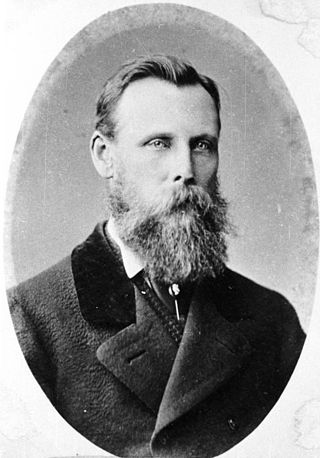| ||||||||||||||||
| Turnout | 1,300 | |||||||||||||||
|---|---|---|---|---|---|---|---|---|---|---|---|---|---|---|---|---|
| ||||||||||||||||
| ||||||||||||||||
The 1889 East Coast by-election was a by-election held on 13 December 1889 in the East Coast electorate during the 10th New Zealand Parliament.
| ||||||||||||||||
| Turnout | 1,300 | |||||||||||||||
|---|---|---|---|---|---|---|---|---|---|---|---|---|---|---|---|---|
| ||||||||||||||||
| ||||||||||||||||
The 1889 East Coast by-election was a by-election held on 13 December 1889 in the East Coast electorate during the 10th New Zealand Parliament.
The by-election was caused by the resignation of the incumbent MP Andrew Graham on 21 October 1889. [1] Graham was in financial difficulty and was later declared bankrupt, which he ascribed to mismanagement of his business whilst he was on a trip to Scotland. [2]
He was replaced by Alexander Creighton Arthur, a local runholder. Lawyer William Lee Rees, who contested the seat twice before unsuccessfully, again stood and came second. Rees was the Liberal Party's selected candidate. [3]
The following table gives the election result:
| Party | Candidate | Votes | % | ±% | |
|---|---|---|---|---|---|
| Independent | Alexander Creighton Arthur | 676 | 52.00 | ||
| Liberal | William Lee Rees | 624 | 48.00 | ||
| Majority | 52 | 4.00 | |||
| Turnout | 1,300 | ||||
Arthur served as MP for East Coast for only one year and was defeated in 1890 by William Kelly. [5] Rees did not recontest the seat in 1890 and instead stood in the City of Auckland electorate and was successful. [6]
City of Auckland was a New Zealand electorate formed for the election of 1853. It existed from 1853 to 1860, and from 1890 to 1905.

East Coast is a New Zealand parliamentary electorate, returning one Member of Parliament to the New Zealand House of Representatives. The electorate first existed from 1871 to 1893, and was recreated in 1999. The current MP for East Coast is Dana Kirkpatrick of the National Party, who has held office since 2023.

Nelson is a New Zealand parliamentary electorate, returning one Member of Parliament to the House of Representatives of New Zealand. From 1853 to 1860, the electorate was called Town of Nelson. From 1860 to 1881, it was City of Nelson. The electorate is the only one that has continuously existed since the 1st Parliament in 1853.

Tauranga is a New Zealand parliamentary electorate, returning one Member of Parliament to the New Zealand House of Representatives. The current MP for Tauranga is Sam Uffindell of the National Party, who won the seat in the 2022 Tauranga by-election, following the resignation of the previous MP, Simon Bridges of the National Party.

Alfred Kingcome Newman was the mayor of Wellington, New Zealand, in 1909–1910, and a Member of Parliament.

George Fisher was a four-time Mayor of Wellington, New Zealand from 1882 to 1885, and in 1896. He represented various Wellington electorates in Parliament for a total of 18 years. He was nicknamed ‘Tarcoola George’.
Mid-Canterbury was a New Zealand parliamentary electorate in rural Canterbury. It existed from 1928 to 1946 and was represented by six Members of Parliament, including Mary Grigg, the first woman National Party MP.
Timaru was a parliamentary electorate, in New Zealand's South Island. It existed continuously from 1861 to 1996 and was represented by eleven Members of Parliament.
Egmont is a former New Zealand electorate, in south Taranaki. It existed from 1871 to 1978.
Thames is a former New Zealand electorate, in the Thames-Coromandel District. It existed from 1871 to 1946.
Bruce was a rural parliamentary electorate in the Otago region of New Zealand, from 1861 to 1922. For part of the 1860s with the influx to Otago of gold-miners it was a multi-member constituency with two members.
Pareora was a former parliamentary electorate in the Canterbury region of New Zealand for one electoral term in the 19th century.
Westland was a parliamentary electorate in the West Coast of New Zealand from 1866 to 1868 and 1890 to 1972. In 1972 the Tasman and West Coast electorates replaced the former Buller and Westland electorates.
Lincoln was a parliamentary electorate in the Canterbury region of New Zealand from 1881 to 1890. It was represented by two Members of Parliament.
Linwood was a parliamentary electorate in Christchurch, New Zealand, from 1887 to 1890. The electorate was represented by one Member of Parliament, Andrew Loughrey.
Ellesmere was a parliamentary electorate in the Canterbury region of New Zealand. It existed for two periods between 1861 and 1928 and was represented by six Members of Parliament.
Auckland North was a parliamentary electorate in Auckland, New Zealand, from 1881 to 1890.

William Lee Rees was an English-born New Zealand cricketer, politician and lawyer.

William Kelly was an Irish migrant to New Zealand, and became a businessman, soldier and politician.

John Ollivier was a Member of Parliament in New Zealand, but was better known for his membership of the Canterbury Provincial Council. He was the second chairman of the Christchurch Town Council.